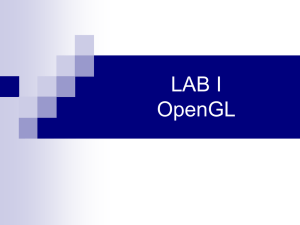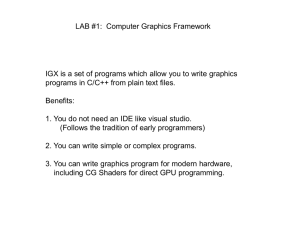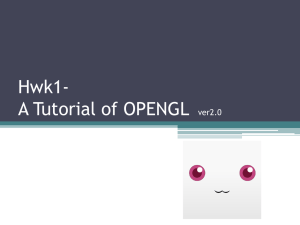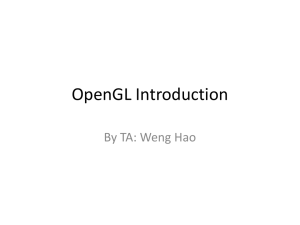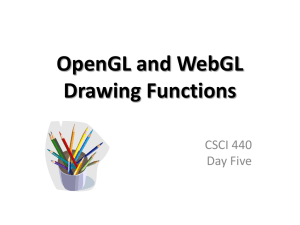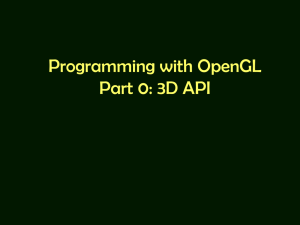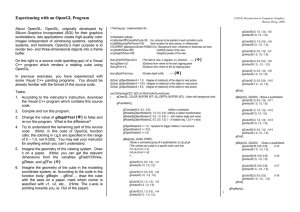Slide - SGLab
advertisement
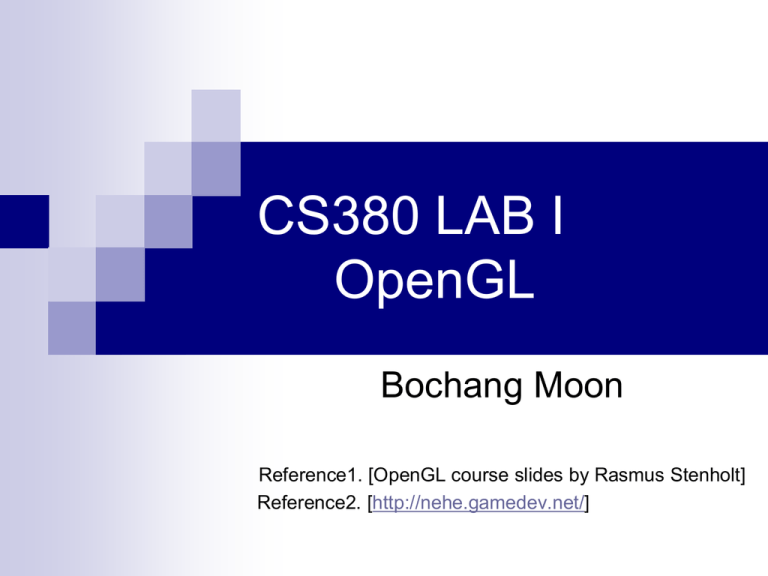
CS380 LAB I
OpenGL
Bochang Moon
Reference1. [OpenGL course slides by Rasmus Stenholt]
Reference2. [http://nehe.gamedev.net/]
Goal
Introduce OpenGL programming
Help you do CS380 homework by yourself
2
Outline
Install Dev-C++ and OpenGL environments
Run
an empty window
Note: Visual C++ with OpenGL is similar
Reference: course slides “Basic OpenGL structure”
Start with the OpenGL framework
Draw
a OpenGL primitive
Address keyboard and mouse input
3
Install Dev-C++
Download Dev-C++ beta 9 release
http://www.bloodshed.net/dev/devcpp.html
Click
4
Install Dev-C++
Just click “Next”
5
Dev-C++ starts up
Click File/New/Project
6
Dev-C++ starts up
Click “Console Application”
7
Dev-C++ starts up
Make a new folder, save the project file
8
Dev-C++ starts up
Click Execute/Compile (Ctrl + F9)
Click Execute/Run (Ctrl + F10)
9
Download and install GLUT
Download GLUT files from
http://chortle.ccsu.edu/Bloodshed/glutming.zip
Extract glutming.zip
10
Download and install GLUT
Copy GLUT files to the install folder of DEV-C++
glut.h:
copy this file to C:\Dev-Cpp\include\GL
libglut32.a: copy (or replace) this file to C:\DEVCpp\lib
glut32.dll: copy this file to C:\Windows\System32
Check whether there is “opengl32.dll” in this folder
11
Download and install GLUT
Project setting in DEV-C++
Click
Project/Project Options
12
Download and install GLUT
Project setting in DEV-C++
Click
Project/Project Options
13
Download and install GLUT
Project setting in DEV-C++
Click
Parameters, and Add Library or Object
14
Download and install GLUT
Project setting in DEV-C++
Add
three library files in this order
C:/Dev-Cpp/lib/libopengl32.a
C:/Dev-Cpp/lib/libglu32.a
C:/Dev-Cpp/lib/libglut32.a
15
Creating an empty window
#include <GL/glut.h>
#include <GL/glu.h>
void display()
{
}
int main( int argc, char* argv[] )
{
glutInit(&argc, argv);
glutInitDisplayMode(GLUT_SINGLE | GLUT_RGBA | GLUT_DEPTH);
glutInitWindowSize(512, 512);
glutCreateWindow("CS380 LAB");
glutDisplayFunc( display );
glutMainLoop();
return 0;
}
16
Draw your first polygon
void display()
Main
display function where we can do all the
drawing
17
Draw your first polygon
Clear your screen
void display() {
glClear(GL_COLOR_BUFFER_BIT | GL_DEPTH_BUFFER_BIT);
glFlush();
}
glClear(parameters) // clear input buffers
glFlush() // forces all pending commands to be executed
18
Draw your first polygon
void display() {
glClear(GL_COLOR_BUFFER_BIT | GL_DEPTH_BUFFER_BIT);
glLoadIdentity();
// Reset our view
glBegin(GL_TRIANGLES); // Draw a triangle
glVertex3f( 0.0f, 1.0f, 0.0f);
glVertex3f(-1.0f,-1.0f, 0.0f);
glVertex3f( 1.0f,-1.0f, 0.0f);
glEnd();
glFlush();
(0,0,0)
}
19
Draw your first polygon
In OpenGL, geometry is specified by vertices
Vertices must be specified between
glBegin(primitive type) and glEnd() function
calls
The primitive type represents how vertices are to be
connected
glBegin(GL_TRIANGLES);
glVertex3f( 0.0f, 1.0f, 0.0f);
glVertex3f(-1.0f,-1.0f, 0.0f);
glVertex3f( 1.0f,-1.0f, 0.0f);
glEnd();
20
OpenGL Primitives
Triangles
There are 3 ways of making triangles with OpenGL
Individual triangles
Type is GL_TRIANGLES
Each triangle requires 3 explicit vertices
Sets of unconnected triangles are often called polygon soups
Strips of connected triangles
GL_TRIANGLES
Type is GL_TRIANGLE_STRIP
The first triangle requires 3 vertices, the rest use 1 new vertex
and the 2 most recently defined vertices
GL_TRIANGLE_STRIP
Complex objects are often built from
Fans of connected triangles
Type is GL_TRIANGLE_FAN
Every triangle use the first, the previous, and a new vertex
Useful for creating polygons or approximating circles/ellipses
GL_TRIANGLE_FAN
21
OpenGL Primitives
Quadrilaterals (quads)
Individual quads
Type is GL_QUADS
A quad is defined by 4 vertices
Quads can be decomposed into
two triangles
Quads are not necessarily plane
or convex
GL_QUADS
Be careful with the vertex
sequence
Strips of connected quads
Type is GL_QUAD_STRIP
Uses the most recent 2 vertices
and 2 new vertices
GL_QUAD_STRIP
22
OpenGL Primitives
Polygons
is GL_POLYGON
Polygons need 3 or more
vertices
Type
I.e. can be used for any
polygon
Polygons
are divided into
triangles by the graphics
card
GL_POLYGON
23
OpenGL Primitives
Points
Type is GL_POINTS
Points are 0-D
Points represent the simplest
drawable primitive
1 vertex is used per point
Points are rendered as small,
unconnected dots on the screen
Theoretically points have no
area
GL_POINTS
24
OpenGL Primitives
Lines
GL_LINES
Type
is GL_LINES
Lines are 1-D
Each line needs 2 vertices
Lines have no area
Open series of lines
Type
GL_LINE_STRIP
is GL_LINE_STRIP
Closed series of lines
Type
is GL_LINE_LOOP
GL_LINE_LOOP
25
OpenGL functions
OpenGL functions all follow the same
naming conventions
Function
names have gl, glu, or glut as prefix
depending on their package of origin
The name of the function follows the prefix
The parameter type of the function is placed
as a postfix
26
OpenGL functions
glVertex3fv( v )
Number of
components
2 - (x,y)
3 - (x,y,z)
4 - (x,y,z,w)
Data Type
b
ub
s
us
i
ui
f
d
-
byte
unsigned byte
short
unsigned short
int
unsigned int
float
double
Vector
omit “v” for
scalar form
glVertex2f( x, y )
27
Tutorial
Draw this rectangle
28
Tutorial
Drawing a red rectangle
glBegin(GL_QUADS);
glVertex3f( -0.5f, -0.5f, 0.0f);
glVertex3f(-0.5f, 0.5f, 0.0f);
glVertex3f( 0.5f, 0.5f, 0.0f);
glVertex3f( 0.5f,-0.5f, 0.0f);
glEnd();
29
Adding colours
glColor3f(red, green, blue)
Drawing a red rectangle
glBegin(GL_QUADS);
glColor3f(1.0f,0.0f,0.0f);
glVertex3f( -0.5f, -0.5f, 0.0f);
glVertex3f(-0.5f, 0.5f, 0.0f);
glVertex3f( 0.5f, 0.5f, 0.0f);
glVertex3f( 0.5f,-0.5f, 0.0f);
glEnd();
30
Colours in OpenGL
Colours are modelled using the red-greenblue (RGB) system
31
Colours in OpenGL
There are several ways of representing colour in
OpenGL
Directly as RGB-tuples
Extended RGBA-tuples
Indexed mode
The RGBA mode has an extra component, alpha,
which does not affect the colour directly
Alpha is used when blending colours
E.g. transparency effects
The indexed mode uses a fixed table of colours to look
up colours
32
Colours in OpenGL
Colours are specified by the glColor*()
family of functions
Example: glColor3f()
Specifies
a colour by three floating point
values in the range [0.0;1.0]
The parameters represent R, G, and B,
respectively
33
Keyboard input
int main( int argc, char* argv[] ) {
glutInit(&argc, argv);
glutInitDisplayMode(GLUT_SINGLE | GLUT_RGBA | GLUT_DEPTH);
glutInitWindowSize( width, height );
glutCreateWindow("CS380");
glutDisplayFunc( display );
glutMouseFunc( mouse );
glutKeyboardFunc( keyboard );
glutReshapeFunc( reshape );
glutMainLoop();
return 0;
}
34
Keyboard input
void keyboard(unsigned char key, int x, int y) {
if (key == 'r') {
// todo
}
glutPostRedisplay();
}
35
Tutorial
Change the color of your rectangle
Press
‘r’: change it to a red rectangle
Press ‘g’: change it to a green rectangle
Press ‘b’: change it to a blue rectangle
36
Tutorial
void display() {
…
glColor3f(r,g,b);
…
}
void keyboard(unsigned char key, int x, int y){
if (key == 'r') {
r = 1.0, g = 0.0, b = 0.0;
}
else if (key == 'g') {
r = 0.0, g = 1.0, b = 0.0;
}
else if (key == 'b') {
r = 0.0, g = 0.0, b = 1.0;
}
glutPostRedisplay();
}
37
Mouse input
int main( int argc, char* argv[] ) {
glutInit(&argc, argv);
glutInitDisplayMode(GLUT_SINGLE | GLUT_RGBA | GLUT_DEPTH);
glutInitWindowSize( width, height );
glutCreateWindow("CS380");
glutDisplayFunc( display );
glutMouseFunc( mouse );
glutKeyboardFunc( keyboard );
glutReshapeFunc( reshape );
glutMainLoop();
return 0;
}
38
Mouse input
void mouse( int button, int state, int mx, int my )
button
state
GLUT_LEFT_BUTTON
GLUT_MIDDLE_BUTTON
GLUT_RIGHT_BUTTON
GLUT_DOWN
GLUT_UP
mx, my
positions
39
Mouse input
void mouse( int button, int state, int mx, int my ) {
if((button == GLUT_LEFT_BUTTON) && (state == GLUT_DOWN) ) {
r = 1.0, g = 1.0, b = 1.0;
display();
}
}
40
Next time
Transformation in OpenGL
41
